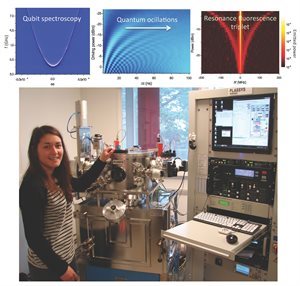May 13 2015
Professor Oleg Astafiev, jointly appointed Professor at Royal Holloway and Visiting Professor at the National Physical Laboratory (NPL), and his team of researchers, have designed, built and operated the first working superconducting qubit devices in the UK.
 PhD student Teresa Hoenigl-Decrinis with an advanced thin-film deposition system. Above Left to Right: Various demonstrations of the quantum mechanical nature of one of the flux qubits.
PhD student Teresa Hoenigl-Decrinis with an advanced thin-film deposition system. Above Left to Right: Various demonstrations of the quantum mechanical nature of one of the flux qubits.
Quantum Bits, or qubits, are the building blocks for a future computer hardware that calculates according to the rules of quantum physics. Able to run programs and perform tasks that our present day computers simply cannot do, quantum computers are thought to be the next major step in the future of computing.
Such computers require electronic components that operate according to the laws of Quantum Physics and one of the most advanced technologies presently under study worldwide for this purpose is that based on superconductors - metals that lose all of their resistance when cooled to temperatures close to the absolute zero of temperature and instead display quantum coherent effects. Potential applications of the new technology, however, spread far beyond the field of quantum computing and include potential advancements in medicine and space exploration.
Professor Astafiev, leader of the NanoPhysics and NanoTechnology research group at Royal Holloway and an expert in the field, made the breakthrough in this new and fast moving technology following an investment of about £1.5 million in advanced research equipment from both Royal Holloway and collaborators at the National Physical Laboratory.
Underpinning this achievement were key advances in the quality of nano-fabrication taken by the team, which includes the expertise of Drs Vladimir Antonov and Rais Shaikhaidarov and PhD students Teresa Hoenigl-Decrinis and Alexei Dmitriev. In the device several qubits are coupled to a microwave transmission line, the images show various aspects of the quantum nature of the device and, importantly, detailed analysis of the data prove the high quality of the design and fabrication process.
Professor Astafiev said: "This is an important milestone for our group and we are very proud of this achievement, many people have worked hard to get us to this stage and I am very grateful for the help and support both the University and the National Physical Laboratory have provided. The devices we are now producing and measuring establish our capability at Royal Holloway as state-of-the-art in the field.
“Our future is very bright, we will move from here to study more complex devices and the most interesting phenomena in macroscopic quantum devices and quantum microwave photonics."
Professor Paul Hogg, Vice-Principal and Dean of the Faculty of Science at Royal Holloway, said: "We congratulate Professor Astafiev on his marvellous success. Oleg's efforts to establish this research area at Royal Holloway put us in a globally competitive position and we are grateful to our partners at NPL for contributing to this work. I wish him every success."
Dr Rhys Lewis of NPL, commented: "We are very proud of Oleg's achievements. NPL's research collaboration with Royal Holloway is proving its worth and is the foundation of a very strong and globally competitive solid-state quantum technology activity for the UK."